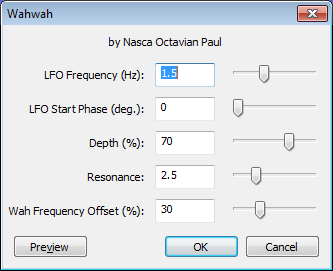Wahwah
From Audacity Manual
LFO Frequency
Sets the speed at which the bandpass filter is swept back and forth.
LFO Start Phase
The start position of the LFO cycle. This determines whether the bandpass filter starts at its lowest, mid or highest frequencies. Another way to look at it is that it determines whether at the start of the effect the pitch is rising or falling.
Depth
Determines the range of frequencies that are swept through by the bandpass filter. Higher values will sweep the filter to higher frequencies and so give more variation to the sound quality over a complete LFO cycle. Lower values will give a more constant sound effect.
Resonance
Determines the degree of resonance in the bandpass filter. Higher values give a more "peaky" effect.
Wah Frequency Offset
Determines the "base" frequency of the bandpass filter. Higher values will shift the filter's frequency range upwards. To achieve a Wah effect that's in the low frequencies the frequency offset needs to be set to a low value.
